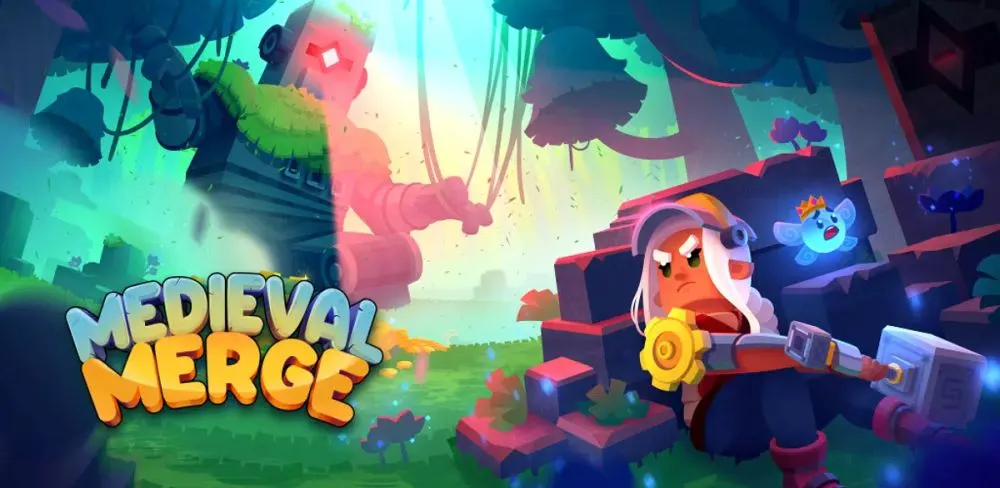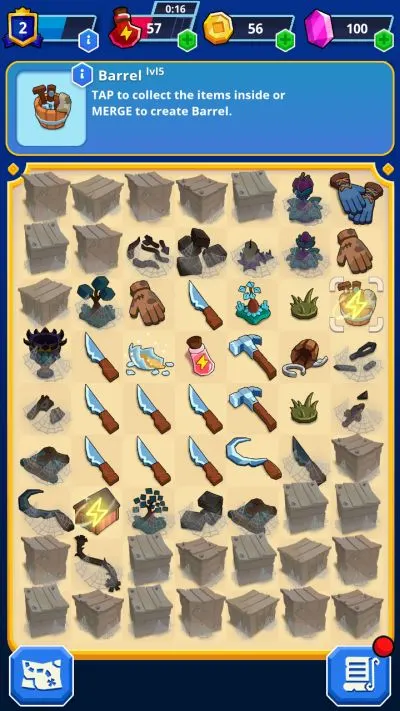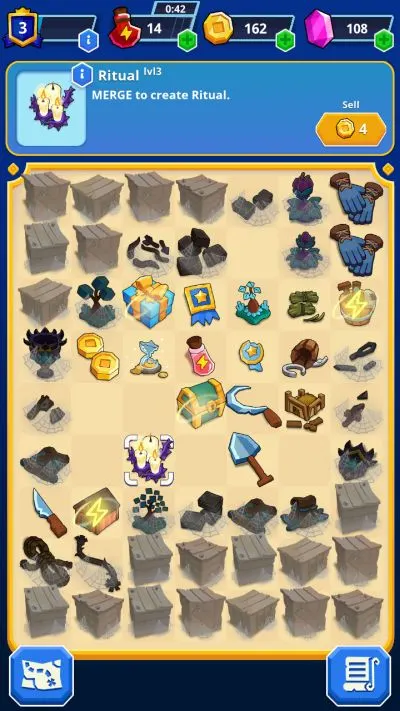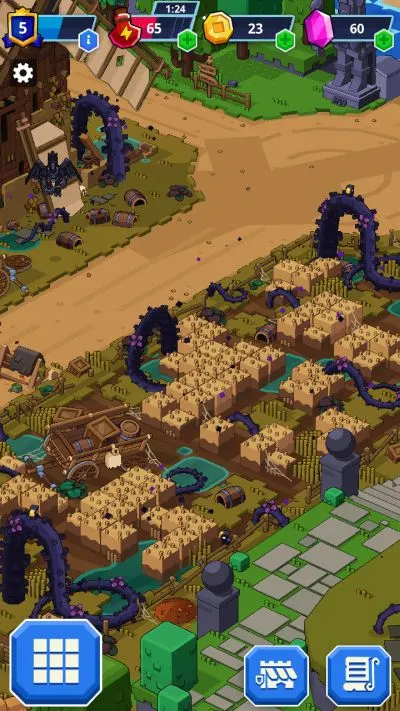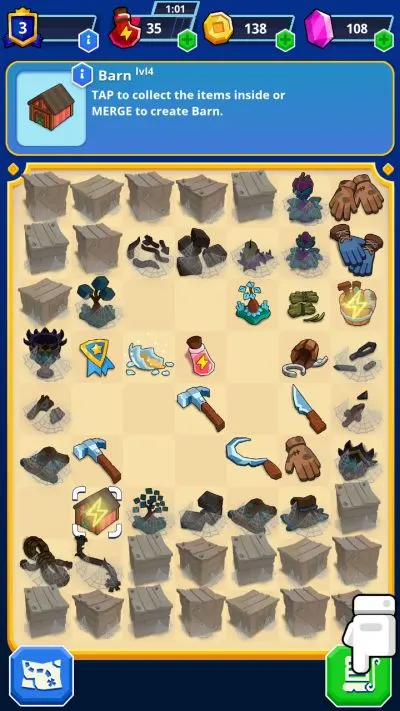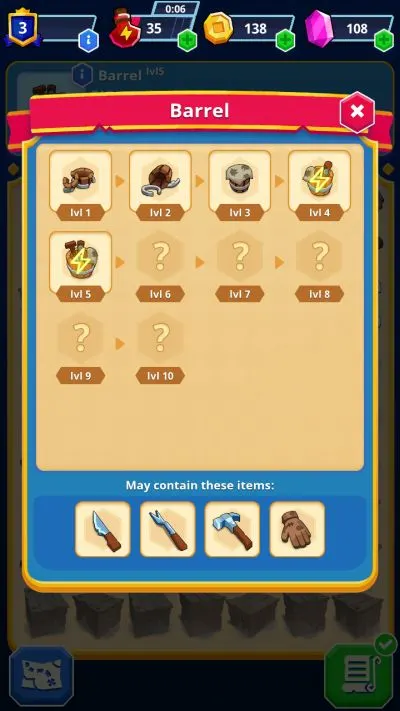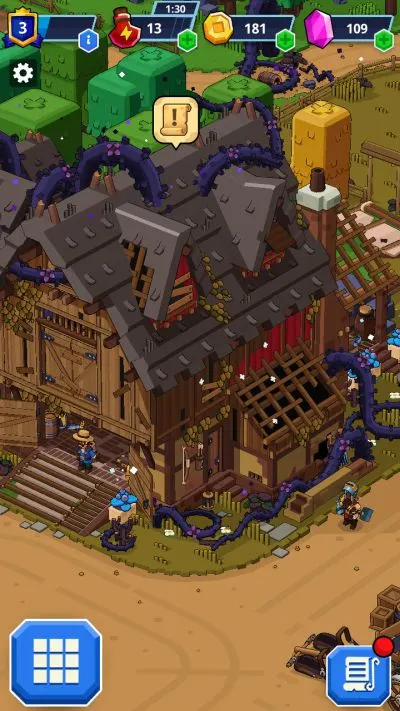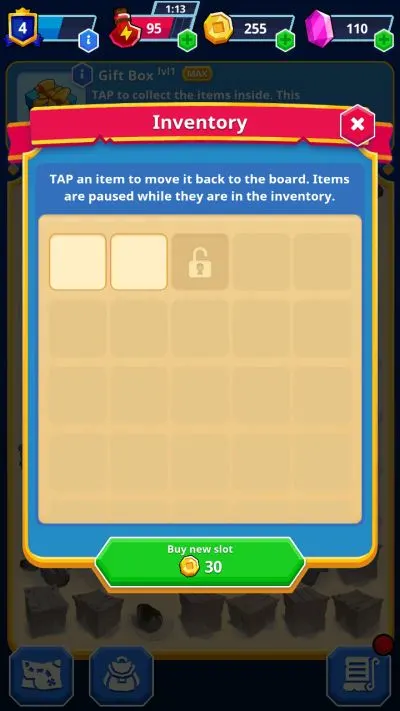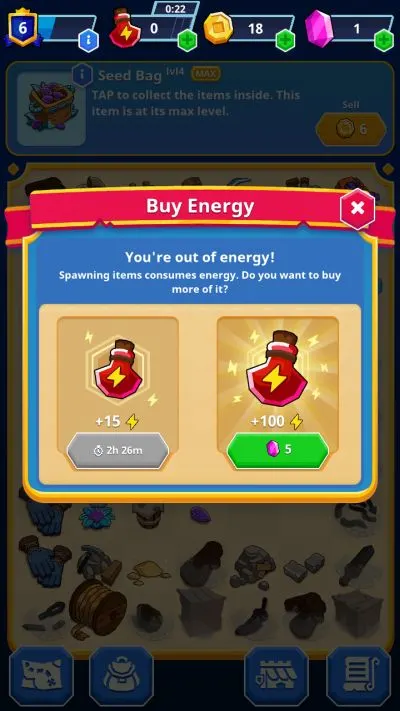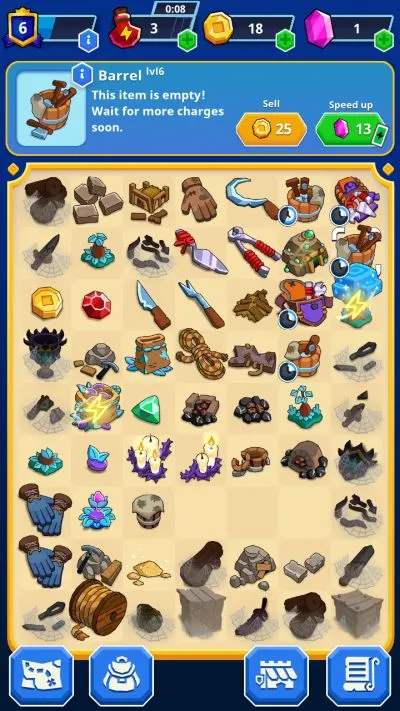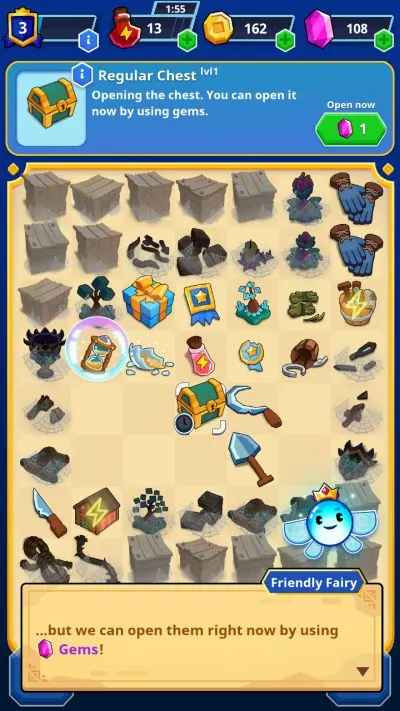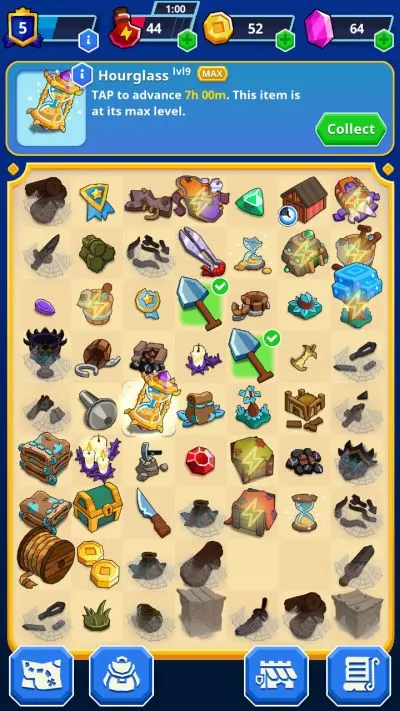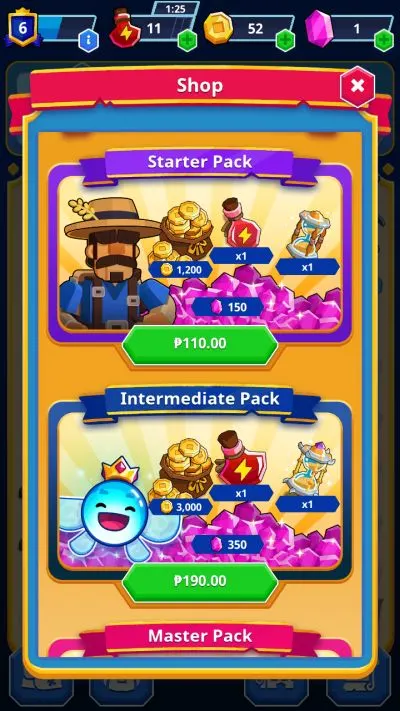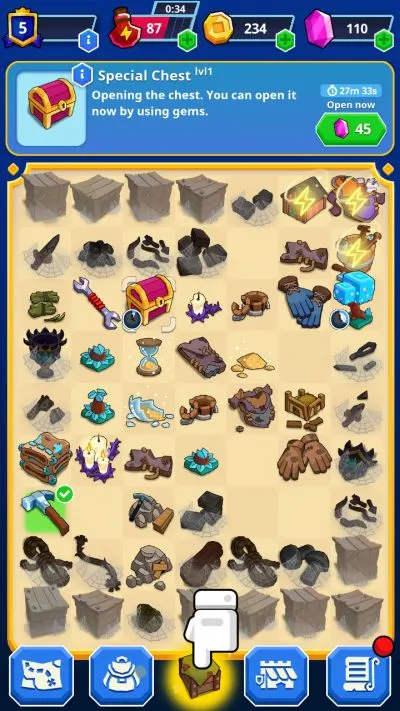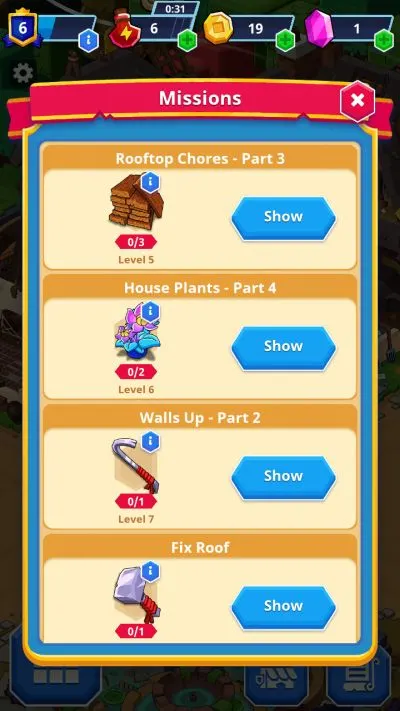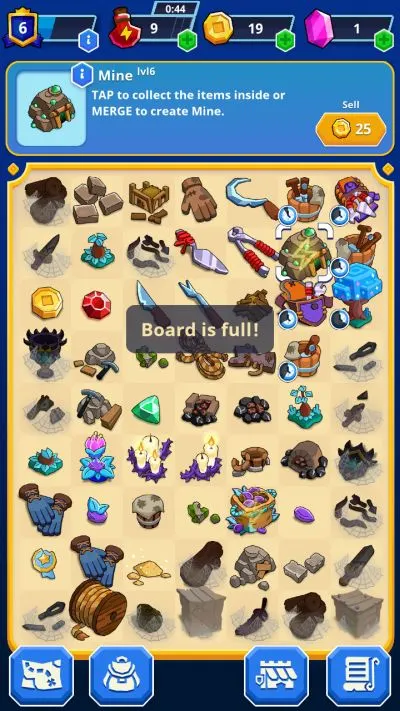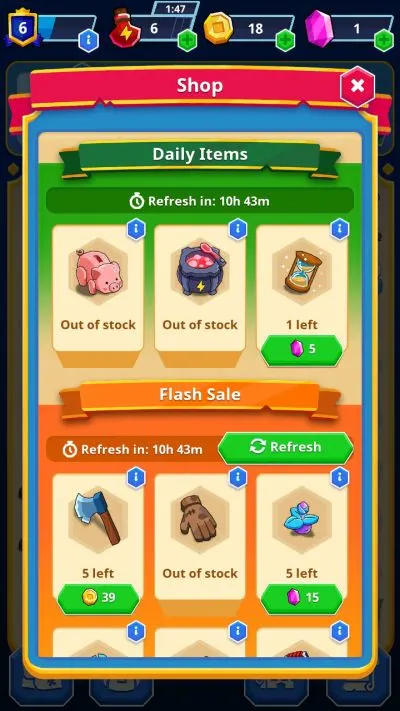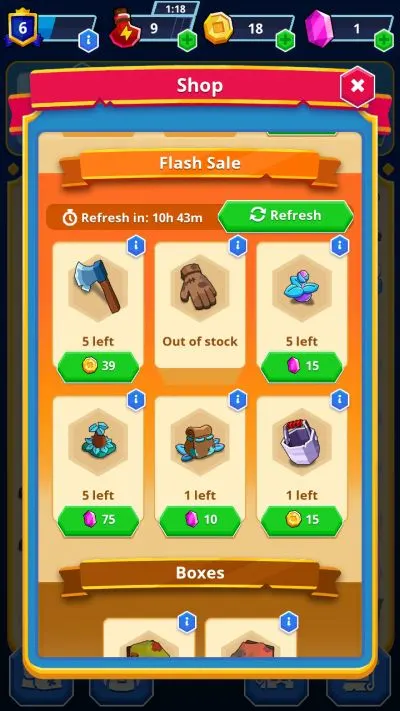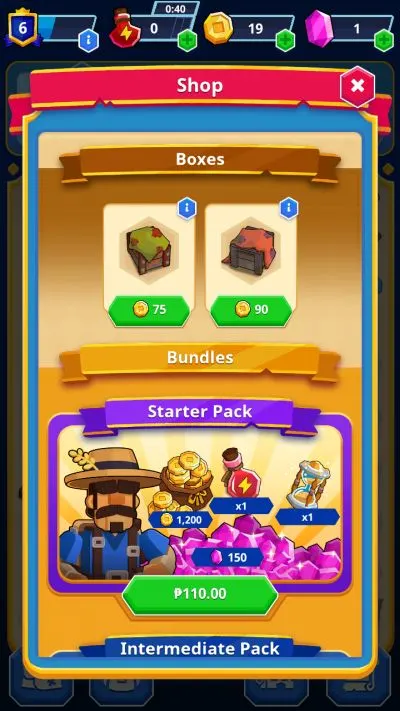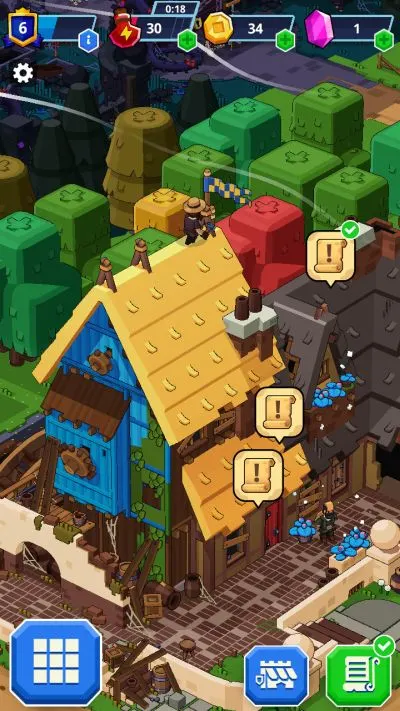Imagine a world where you can just pull out anything you need at the drop of a hat, whether that’s a sword to vanquish your foes, a billhook to slice some annoying roof vines, or bricks to rebuild a wall. Medieval Merge lets you do just that.
Medieval Merge is a game where you enter the shoes of the brave Astoria in a quest to rebuild a village ravaged by monsters while embarking on your own journey. If you’re a fan of older alchemy style games where you combine items, Medieval Merge is right up your alley. Medieval Merge is available on both the Google Play Store and the App Store.
Medieval Merge’s gameplay is simple, addicting, and highly intuitive. However, if you’d like some tips and tricks on how to get the most out of your merging, then be sure to stay with us and check out our detailed Medieval Merge beginner’s guide!
Merging 101
To progress in your quest, you’re going to need several tools. You won’t just need standard fare like knives, weeders, hammers, or wrenches – you’re also going to need to dabble in horticulture, blacksmithing, masonry, woodwork, and so much more. Luckily, you don’t have to study all those when you have an even greater discipline tucked under your belt, namely merging.
Merging items forms the game’s core. By putting two similar items together, you can create a new item. This gives you the unrivaled ability to adapt to any situation at hand, whether that’s repairing a house, planting new flowers, or beating the tar out of monsters. It’s also always nice to have a handy-dandy toolbox at the ready at all times!
The Merging Board and The Fusion Dance
The merging board is where you’ll work your merging magic and dump your resources.
It looks like a dump, doesn’t it?
Let’s start cleaning up by merging items. To merge items, simply pick up an item by holding on it, then drop it over a similar item. Voila – new item!
Any item on the board that’s highlighted is something we can pick up and move. By continuously merging items, we can create any tool that we need. It’s also important to note (and remember) each item’s unique upgrade tree: two knives (which are both level 1 tools) can be merged to create one level two weeder.
Two weeders become a hammer, two hammers become an axe, two axes become a sickle, and so on. If you want to see an item’s upgrade path, you can tap the blue info button that appears on the item’s icon in the upper part of the screen.
To gain more space and to clean up that awful mess, you can (and should) drag mergable tools to those grayed-out and filthy items around your borders. This will both merge those two items and free up that space, allowing you to place more items on your merging board. As a rule of thumb, always try to merge your current items with the grayed out items if you can.
Lost in the Merge
It’s very easy to lose track of exactly what items are on your board at any given time. If you want to know if an item can be merged, you can sit still and leave your items to chill for a while. Every so often, pairs of similar items will pop out, giving you an indication that they can be merged. This is especially useful for grayed-out items, whose figures can be obscured by dust and cobwebs.
If you’d like to make things easier for you, you can also manually reorganize your merging board by dragging things around. If two items cannot be merged, they’ll instead swap position, which I use to put similar items that can’t yet be merged together. Do note that you can’t do this with grayed-out items – you’ll first need to unlock them via a merge.
It’s very, very easy to populate your board with things you don’t need. If you find yourself in dire need of space, you can either sell items for a small amount of gold or move them to the inventory (more on that later). Likewise, you can instantly unlock grayed-out items by paying a small sum of Gems.
Resource Generation
To replenish your stock of tools, you’ll need to find and merge some special items on the merging grid. Among these are barrels and barns. A telltale lightning bolt will appear on these items on your board, so you don’t lose track of them.
These items are special in that they’re not directly used in the overworld. Instead, you can use them to spawn in low-level resources. To do that, just tap on the item in question, and it’ll fill an empty slot with an item it can produce. Be wary though – generating items costs energy, so try and be economical with your merging.
Do note that these items need to be sufficiently repaired before they can be used as resource generators – this is usually around level 3 or 4. You should always upgrade these generators whenever you can, as doing this increases the chance that a resource generator will spawn better items. Better items mean less energy spent and less time merging.
If you’d like to see what items a resource generator can produce, you can tap on the blue info button on the top part of the panel. This can also serve as a hint if a quest requires an item that you’ve never seen before as you can see what generator creates that item.
Each resource generator also runs on its own mechanics. While some, like the barrel, stay forever, others can be depleted, or regenerate over time. For resource generators that replenish over time, you can either watch an ad or pay Gems to instantly refill them. With that in mind, it’s a good idea to gauge your resource generator usage before merging every single one of them – in my case, I found it was better to have 2-3 barrels producing knives than just one that had a good chance to produce hammers.
One last thing you should be aware of regarding resource generators is that if they would remove themselves from the board when generating their last resource, you don’t need the extra space: the new item will take the spot of the now-vanished generator.
The Inventory
Medieval Merge tends to vomit a lot of resources at you – whether that’s level up bonuses, gift boxes, or your own fault for tapping that barrel one too many times. This is where the game’s inventory system comes into play.
To unlock the inventory system, you’ll need to be at level 4 and have a board completely filled. Ivan will then open the inventory system and force you to buy one slot, bringing you to a grand total of 2 slots.
The inventory is where you can stash items that you don’t think you need, but aren’t willing to throw away for gold. While it starts small, you can spend gold to open up more slots, increasing your storage space and giving you greater freedom in merging. To put an item into your inventory, tap and hold to pick it up, then drag it down to the inventory item at the bottom and let go.
On a side note, I highly suggest stashing all the gloves (level 3) you merge or pickup in your inventory – you’re going to need a lot of them down the road. You’ll thank me later once you realize how low the glove spawn chance from the barrel is.
Energy
Since you need energy to generate items (there’s no such thing as infinite, free energy), you’re going to run out of it really fast. Couple that with the low regeneration rate of energy – 1 energy per 2 minutes – and you’ll definitely want a way to get more energy.
First off, if you haven’t yet hit zero energy, I suggest you do it. The very first time you hit zero energy, Ivan will tempt you into spending Gems to refill 100 energy; at the same time, he gives you a freebie – 1 gem for 100 energy. After that though, you’ll need to be more economical in how you spend your energy.
Running out of energy also gives you the option to restore 15 energy by watching an ad. I haven’t pinned down the exact cooldown of watching ads for energy, but it seems that you can watch ads up to two times, and they share a cooldown of 3 hours.
While energy is undoubtedly very important, you should remember that Medieval Merge also runs on time-gating mechanics and that high energy isn’t always the key to progress. Before buying energy or spending resources to get more energy, check if your resource generators can keep up with the extra production you’re going to need.
Other ways of earning energy are using hourglasses to accelerate time or by using energy potions, which I’ll discuss further below.
Merging: Advanced Items
It’s not just items and tools that you’ll be combining in Medieval Merge. Most pickups and bonuses are actually thrown onto your merging board, and yes – you do have the freedom to merge them as you please.
Pickups: Experience, Gold, and Gems
Among the most common bonus items that get thrown on your board are experience medals, gold, and Gems.
While at first it may sound annoying that you have to manually pick up your hard-earned goodies, this is actually a great opportunity. Following the theme of this game, even pickups can be merged to increase their potency.
This presents you with an interesting choice: either eat the bonus exp, Gems, and gold now, or keep merging them to get a bigger payoff later – and the points gained per merging are more than the sum of the parts. There’s no single right way to play the game, but I suggest keeping and merging them until you find yourself in dire need.
One final thing I’ll add here is that it’s relatively easy to get bonus experience medals as they often spawn after merging items that are at least level 4, such as 2 axes into a sickle. This will produce a level 1 experience medal that gives 1 experience point. Paltry, yes. I suggest keeping a dedicated spot on your board solely for hoarding experience medals, and that you merge medals until you can get at least 20 experience points out of them.
Hourglasses
Hourglasses are special pickups that allow you to extend your energy and resource further than they would first seem. When you use an hourglass, all countdown timers – whether that’s energy, resource generation, or chest opening – are accelerated by the amount listed in the hourglass’s info panel.
Energy Potions
Energy potions are another kind of pickup that yes, give you energy.
Just like other bonus pickups, these bottles of red goodness are thrown at your board, and it’s up to you to eat them individually (do not do this) or merge them into bigger vials before consuming them for a bigger payoff (do this). Alternately, you can put some energy potions in your bag if you think you won’t need them for a while – such as if your resource generators are all on cooldown.
Chests
Ah, chests. Who doesn’t like a colorful box of goodies?
Unfortunately, there’s an extra hoop you have to jump through to get your hands on a chest’s contents – namely, chests require time to open. Depending on the contents of the chest, the waiting time can range from a couple of minutes to hours.
Of course, there’s a way to skirt this waiting time, and if you said “Gems”, then you’re spot-on. I highly advise against doing this as even if you pay Gems, you’re going to get the same items from the chest anyway, and waiting the chest out costs nothing but time and patience. Do note, however, that you will need to tap Open on a chest before the countdown starts. You should also keep in mind that despite our ability to pull tools out of mid-air, we can only open one chest at a time.
Bubbles
Bubbles are similar to chests in that they’re locked behind time-gated mechanics. Occasionally, merging high-level items (around level 4 or so) creates double the product, but that bonus item is locked behind a bubble. The bubble can only be popped with gems, and if you opt to not pop the bubble before its timer runs out, that bonus item will vanish. When a bubble vanishes, it occasionally drops a low-level consolation prize, mostly gold.It’s entirely at your discretion whether the bubbled item is worth the Gem cost or not.
A-Questing We Will Go
All action in Medieval Merge is driven via quests.
Quests are denoted by a scroll with an exclamation point in the overworld. By tapping these quests, you’ll be able to see exactly what items you need to craft and use up to complete that quest. Tapping on a quest also shows you the rewards you’ll get for completing said quest.
Alternately, you can tap on the quests tab in the lower right, via the scroll the button. This quest screen also shows you all quests that are available to you – including those that are locked away due to your level being too low.
To Each, According to its Requirement
Because you can see what items you need for each quest, as well as the high cost of producing and merging materials, I highly suggest you do not produce anything above level 2 items unless a quest asks for it. Making too many items not only burns away precious energy, but also takes up valuable board space that you’ll need. Compounding that is the fact that you can’t separate merged items into their constituent parts, meaning that every move you make must be both calculated and necessary.
For perspective, let’s say a quest requires you to make a sickle, a level 5 tool. To make that, you’ll need to start out by summoning knives from your otherworldly pockets. Two knives make a weeder, two weeders into a hammer, two hammers into an axe, and two axes into a sickle. If you craft this sickle creating only knives, you’ll need to have produced 16 knives, meaning that you’ve burnt 16 energy – and that’s if your barrels produced only knives.
Quest Rewards
All quests give out rewards, most commonly via gold and experience that’s added directly to your stores. Some quests also give out treasure chests, which can yield rare and valuable items such as new resource generators and hourglasses.
Visit The Shop
If you’re out of vital resources or need a specific item, why not pay the shop a visit?
The shop is an integral part of Medieval Merge, and you should always, always, ALWAYS visit the shop. To access the shop, tap on the shop icon – it’s on the lower right part of the screen.
Daily Items
First off, the shop sells a few limited daily items, each of which provides unique and important bonuses to your board. The first item is a piggy bank that you can then shake down for gold and Gems. While it does admittedly give low amounts (as in 1 gold or 1 Gem), you can fuse these to gain more substantial amounts of resources.
The next item is a cauldron, which you might have already seen from one of your quest completion or level up rewards. This fancy pot contains energy potions, which are always welcome. To get your free daily cauldron, you’ll need to watch an ad – a small price to pay, in my opinion.
Finally, the third daily item is an hourglass. This daily item requires a small amount of Gems to purchase, and your mileage will vary on its usefulness. On one hand, this hourglass is ready to go; on the other, it doesn’t provide much of a bonus by itself as it’s a 10 minute hourglass.
Flash Sale Stock
The shop also stocks random items for your board under the flash sale section. Here you’ll find an assortment of items jumbled together – some useful, others not so much.
These items, depending on what they are or how rare they are, will cost a varying amount of either gold or Gems. With that in mind, I suggest buying out the flash sale section’s gold items as you’re probably going to need them, whether as-is or for merging.
The flash sale section refreshes itself after some time. If you’re impatient, you can refresh the stock instantly either by paying Gems or by watching an ad.
Boxes
The last items you can purchase with in-game currency are boxes.
Boxes are deployable resource generators that produce grayed-out items. This limits the usefulness of the box as while they do give you free resources, they can only be used solely as merge targets, not merge starters. This means you already need to have copies of the items a box will give you to be able to use the box at all.
There are two kinds of boxes that each produce different items. The green box can produce barrel items, as well as a level 1 seed bag. The red box produces toolbox items, includiung rope.
Play at Your Own Pace
Medieval Merge isn’t a game where you need to make optimal plays or jump into with full awareness of everything in the game. Ultimately, Medieval Merge is a single player game – there’s no PVP, no guilds, no raids, and as such, you should always play how you want to play.
With that, our Medieval Merge beginner’s guide comes to an end, and I hope you’ve picked up some stuff that will help you in your quest to rebuild your village. If there’s anything you’d like to add or something else you wish you knew when you were starting out, make yourself heard in the comment section below!

